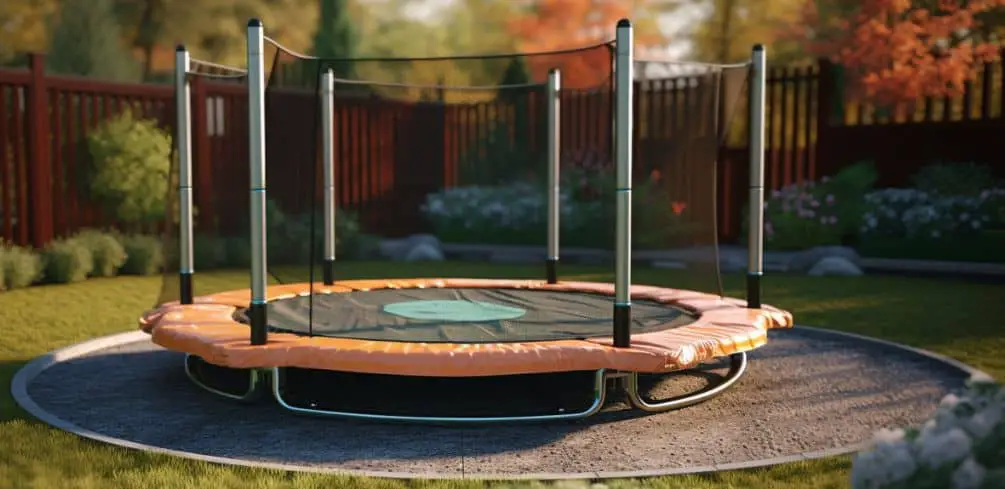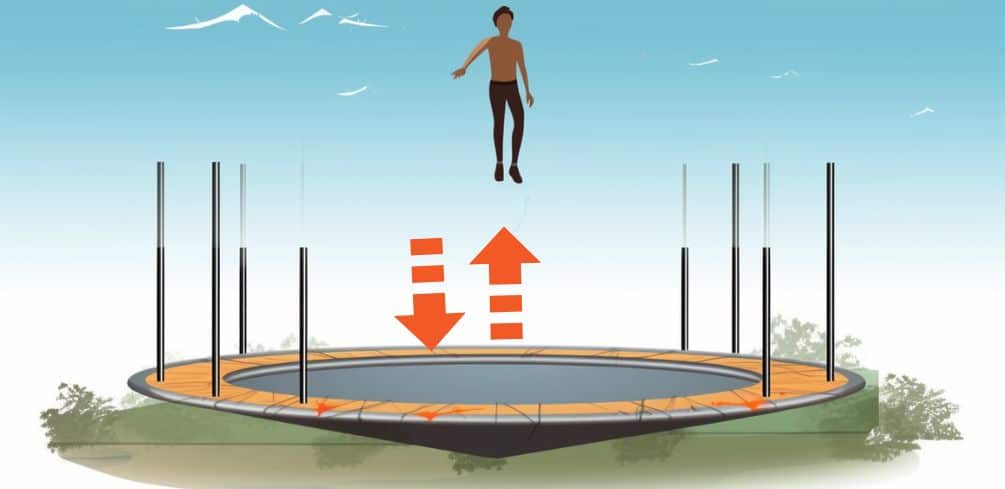Did you know that trampolining has been shown to be three times more effective at burning calories than running? That’s right, and this fun and exhilarating activity isn’t just for kids; it offers numerous health benefits for people of all ages.
You’ll learn how each part of the trampoline contributes to its overall performance, from the bed surface and springs to the frame itself. We’ll also discuss important safety measures and precautions to keep in mind while using a trampoline.
The Science Behind the Bounce

Believe it or not, there’s a whole lot of fascinating science behind that exhilarating bounce you experience on a trampoline. Bounce physics comes into play the moment your feet leave the ground to the highest point of your jump.
To better understand this phenomenon, we’ll delve into jump height, acceleration forces, material properties, and air resistance concepts. When you first land on the trampoline mat after jumping, your body exerts a downward force upon it; in response, the mat stretches and stores potential energy due to its elastic properties.
As you continue to move downwards and reach a maximum stretch capacity of the material (trampoline springs), all that stored potential energy is then converted back into kinetic energy as an upward force acting against gravity.
The acceleration forces generated through this process are what propel you upwards with greater velocity than if you were jumping on solid ground—thus achieving impressive jump heights.
The role of air resistance shouldn’t be underestimated either. In fact, it plays a crucial part in determining how high and long one might stay airborne during a trampoline bounce session.
When ascending at rapid speeds from your initial contact with the trampoline surface up until peak height is reached, air resistance works against your upward motion by creating drag which slows down ascent speed gradually over time.
But when descending back towards the mat surface after reaching peak altitude, air resistance helps slow down the descent rate, allowing for softer landings overall while preserving some potential energy for subsequent bounces.
By understanding these key factors at work during every stage of a trampoline bounce sequence—from initial impact through ascent and eventual descent—you can appreciate how remarkable this seemingly simple recreational activity is!
Components of a Trampoline

You’d be surprised to know that 82% of trampoline injuries are caused by falling on the springs and frame, which are essential components of a trampoline. To ensure a safe and enjoyable experience, it’s crucial to understand the different options available when it comes to spring configurations, frame materials, jumping mat fabrics, enclosure net designs, and pad thickness.
Each of these components plays a vital role in the overall performance and safety of a trampoline. Springs made from galvanized steel offer better durability against rusting compared to regular steel springs.
The frame provides support for the entire structure and needs to withstand repeated impacts without bending or breaking. Galvanized or powder-coated steel frames are popular choices since they resist corrosion well over time.
The springs are responsible for creating the bounce in a trampoline. They come in various lengths, coil densities, and materials – all affecting how responsive and comfortable your bouncing experience will be. Polypropylene (PP) is commonly used due to its UV resistance and ability to maintain its elasticity even under constant use; however, PVC mats can also provide excellent performance but may not last as long outdoors.
Safety features such as enclosure nets should not be overlooked when evaluating trampolines either. Enclosure net designs play a critical role in preventing jumpers from accidentally landing off the mat area or coming into contact with springs and frames during their bouncing sessions – reducing injury risks significantly.
Moreover, pad thickness contributes to cushioning any accidental falls onto the springs or frame parts; hence thicker pads provide better protection.
Understanding these various components allows you to make an informed decision when purchasing your next trampoline – ensuring that it meets both safety standards and personal preferences for optimal enjoyment while minimizing potential hazards associated with improper equipment selection or setup.
So go ahead now with confidence knowing you’re prepared with the essential knowledge to find the perfect trampoline for your needs.
Understanding Elasticity and Energy Transfer

Diving into the science behind trampolines, it’s fascinating to explore how elasticity and energy transfer play crucial roles in providing that thrilling bounce we all love. Elasticity applications are found throughout the trampoline design, with material properties carefully chosen for their ability to stretch and return to their original shape.
This is essential for converting potential energy stored in the stretched materials into kinetic energy, propelling us upwards as the tension forces within them seek to restore equilibrium.
| Physics Principles | Energy Conservation | Tension Forces |
|---|---|---|
| Elasticity | Potential Energy -> Kinetic Energy | Material Deformation |
| Hooke’s Law | Work-Energy Principle | Equilibrium Restoration |
| Material Properties | Mechanical Advantage | Force Distribution |
Understanding these physics principles allows us to appreciate how a trampoline’s components work together harmoniously. When you jump on a trampoline, your body weight compresses its springs and stretches the fabric mat.
As tension forces build up within these elastic materials, they store potential energy equal to the work done by your body during compression. According to the work-energy principle and energy conservation laws, this potential energy ultimately converts into kinetic energy once you release pressure from the springs and fabric – thus launching you back upwards.
As you marvel at each soaring bounce on a trampoline, remember that it is thanks to the intricate interplay between elasticity applications, material properties, physics principles like Hooke’s Law (which governs spring behavior), and tension forces continually seeking balance within deformed materials.
By harnessing our understanding of these concepts through careful engineering choices, trampolines can offer an exhilarating experience that truly defies gravity while adhering firmly to the fundamental laws of nature.
Safety Measures and Precautions

While soaring through the air is undeniably fun, it’s important to prioritize safety and take necessary precautions when using a trampoline. Proper supervision is crucial for injury prevention, particularly when children are jumping.
Adult presence helps ensure that jumpers follow guidelines such as one person at a time on the trampoline, no roughhousing or flips without professional training, and maintaining awareness of their surroundings.
Enclosure nets also play a significant role in preventing falls off the trampoline by creating a barrier between the jumper and the ground below.
Another essential aspect of trampoline safety is adhering to weight limits. Each trampoline model has its own specific weight capacity, which should not be exceeded to minimize strain on the springs and mat. Overloading can lead to equipment failure or injuries due to inadequate support for jumpers’ weight.
Additionally, anchoring trampolines securely to the ground can prevent them from tipping over or moving during use – especially in windy conditions. This ensures stability during jumps and reduces risks associated with an unstable surface.
Taking these precautionary measures seriously will allow you to enjoy your trampoline experience safely while reducing potential hazards significantly. Regular inspections of your trampoline components (springs, pads, mat) help keep track of wear-and-tear signs that may require maintenance or replacement parts – ensuring optimal bounce performance and longevity of your investment.
By implementing proper supervision, respecting weight limits, installing enclosure nets, and anchoring your trampoline securely, you’ll provide yourself and others with confidence in participating in this exhilarating activity without compromising safety standards.
Benefits of Trampoline Exercise

Bouncing on a trampoline, you’ll find yourself immersed in a world of exhilarating fun and fitness, effortlessly combining the joy of weightlessness with the benefits of a full-body workout.
One of the main advantages of trampoline exercise is its low-impact nature. Unlike traditional forms of cardio like running or jumping rope, which can put stress on your joints, trampolining provides a cushioned surface that absorbs much of the shock from each bounce.
This makes it an ideal form of exercise for people with joint pain or those looking to reduce their risk of injury while still getting an effective cardio boost.
Another significant benefit derived from trampolining is improved balance and coordination. When bouncing on a trampoline, your body must constantly adjust to maintain equilibrium as you shift through various aerial positions.
Over time, this constant adjustment helps develop your proprioceptive sense – the ability to know where your body is in space without looking at it – leading to enhanced balance and spatial awareness in everyday activities.
Additionally, engaging in regular trampoline workouts can also contribute positively to lymphatic flow by stimulating circulation and promoting detoxification throughout your body.
As you continue incorporating trampoline exercise into your fitness routine, you’re likely to notice core strengthening as well.
The act of bouncing requires engagement from numerous muscle groups, including abdominals, lower back muscles, obliques – essentially everything that constitutes your core region. Maintaining stability during jumps and mastering complex movements further engages these muscles resulting in increased strength over time.
Moreover, since bouncing on a trampoline often involves multiple muscle groups working together simultaneously – such as legs when pushing off or arms when performing tricks – it serves as an excellent way for total-body conditioning that’s both enjoyable and efficient!
Frequently Asked Questions
How do weather conditions affect the performance of a trampoline’s lifespan?
Weather conditions impact your trampoline’s performance and lifespan significantly. Weatherproof materials combat sun exposure damage, while wind resistance, cold temperature effects, and rain drainage solutions preserve their functionality and longevity.
What are the key differences between recreational and professional trampolines?
You’ll notice key differences between recreational and professional trampolines in safety measures, material, and skill progression requirements. Recreational trampolines focus on fun benefits, while professionals need specialized training equipment.
How can I maintain my trampoline for optimal performance?
To maintain your trampoline, store it properly, install safety accessories, clean the surface regularly, adhere to weight limits, and inspect the frame. Proper care ensures optimal performance and safety for all users.
What are some creative games that can be enjoyed on a trampoline beyond basic jumping?
Explore trampoline dodgeball, create obstacle courses, engage in bounce battles, practice trampoline yoga, or try synchronized bouncing. These activities offer unique challenges and excitement beyond basic jumping for endless fun.
Are there specific exercises that can help improve trampoline skills?
Master techniques through skill progression and exercise variety for injury prevention. Focus on safe bouncing, practice balanced landings, and strengthen core muscles to enhance your trampoline experience while reducing risks.
Conclusion
So, now you’ve delved into the world of trampolines and uncovered the science behind that exhilarating bounce.
It’s undeniable that a mix of elasticity, energy transfer, and well-designed components all play their part in giving you that thrilling experience.
Don’t just take our word for it – give it a try yourself! With proper safety measures in place, enjoy the benefits of trampoline exercise while experiencing firsthand the truth behind this fascinating theory.




